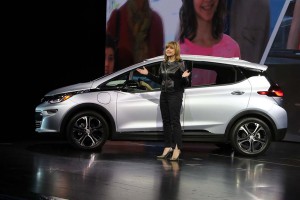The launch of the new Chevrolet Bolt is likely to mark the start, rather than the end, of General Motors’ electrification efforts, a number of company officials tell TheDetroitBureau.com.
And though CEO Mary Barra was not ready to comment about future models during a media roundtable in Las Vegas, she stressed the speed with which GM will have gone from concept to customer with the 200-mile Bolt. It was first revealed in prototype form at the 2015 Detroit Auto Show, returning in production form at this week’s Consumer Electronics Show. The Chevy Bolt will be on sale later this year.
“That speaks to the speed of this technology team,” said Barra, adding that, “We are committed to electrification. We see it as a very important part” of the GM portfolio.
With the launch of the long-range electric vehicle, the Chevrolet brand will have four electrified models representing the three major variants of battery-based powertrains:
- A gas-electric model, the Malibu Hybrid;
- The plug-in Chevrolet Volt newly redesigned for 2016;
- The short-range pure battery-electric Spark; and
- The long-range Chevy Bolt.
At a price tag expected to come in around $30,000 after factoring in the federal tax credit, the Bolt will be targeting a relatively mainstream audience by addressing two key obstacles to broader consumer acceptance, range and price..
(Click Here for a first drive of the Chevrolet Bolt.)
“All of our data says consideration goes up dramatically with a range of over 150 miles,” said Pam Fletcher, the chief engineer of the Chevrolet Bolt project and other plug-based programs.
The launch of the Bolt – along with the debut of the second-generation Chevy Volt – could test just how many more consumers will now consider electrified vehicles. What’s clear is that sales of plug-based models actually tumbled during 2015, analysts generally blaming that on cheap gasoline.
For his part, GM global vehicle development chief Mark Reuss isn’t so sure. He noted that a large share of the hybrids and plug-based products on the road last year were old by automotive standards. He’s not the only one sharing that sentiment. Toyota is betting that the complete, 2016 model-year remake of its Prius will help revive sales of the hybrid.
Industry officials have to hope they can lure in more mainstream buyers for their battery cars, trucks and crossovers. Tough new emissions and mileage standards will force them to use various forms of electrification in an increasing range of models. That could prove a problem if they can’t sell those products.
(GM CEO Mary Barra adds “chairman” to her title. for more.)
One positive factor is the sharp decline in the price of batteries. At the Las Vegas roundtable, Reuss confirmed the battery cells used for the Chevrolet Bolt will cost GM just $145 per kilowatt-hour. Considering the vehicle will have about 60 kWh of lithium-ion cells – GM has not yet released final numbers – that would translate into a savings of as much as $50,000 per vehicles compared to what it would have spent on batteries at the beginning of the decade.
The cost of bringing new battery-based products to market is still costly, and a new report from Japan suggests GM might be looking to partner with Honda on the development of some plug models. The two companies are already working together on hydrogen fuel-cell research, Honda set to launch its Clarity model later this year.
(Why is GM investing $500 million investment in Lyft, Click Here.)
Going forward, GM is likely to look for other ways to excite buyers about battery power. Among the projects under study, and very likely under development, several sources hinted, the maker may use hybrid technology to boost performance. Electric motors actually generate tremendous torque instantly, a factor worked into several high-line competitors flagship products, such as the Porsche 918 Spyder and the LaFerrari.
Going forward, we could see GM use electrification in a number of ways, from high-performance hybrids to plug-ins, perhaps even pure battery-electric performance models, such as the one rival Audi is currently developing.




Like all major car makers, GM has no choice but to build EVs to try and get sufficient credits to still be able to sell proper autos and comply with the insane 54.5 mpg CAFE decree. The good news is that Obama will be gone soon and Congress is already writing bills to undue some of the damage that Obama has imposed on the populace. Hopefully the EPA politicians will be replaced with competent engineers and the U.S. will finally develop a reasonable, practical, workable evolutionary energy policy instead of the hair brain crap that has dribbled out of DC and the EPA. Most people are willing to make some sacrifice to improve the environment in a rational, realistic manner but few people agree with the meritless insanity mandated by Obama and the EPA.